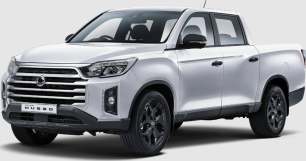The cabin of the XLV Ultimate is big on space and all occupants enjoy fantastic head- and legroom.
Individual storage is good for a ute with the front enjoying two cupholders, a good-sized middle console and glove box plus a drink bottle holder in each door.
Rear occupants get map pockets, a fold-down armrest with two cupholders and storage bins in each door.
Amenities on the whole are good with the heated and ventilated front seats that feature lumbar support. But the upgrade to electric control for the fronts and heat function for the rear outboard positions clinch the luxury factor Both rows are well-cushioned and comfortable for long journeys.
Charging options are limited to the front with two USB-C ports, which is an upgrade from the old USB-A ports, and two 12-volt sockets.
But one of them is an old-school cigarette lighter which I haven’t seen in years! Now that was a teachable moment when I was a kid.
It's a shame there are no charging options in the rear as it could be inconvenient if you travel a lot and your kidlets have devices.
Fitting a child seat in the rear row is a little awkward due to the backrest folding down in one piece and it misses out on any clever hacks like some other utes have, like the zippered accessed points to the top-tether anchor points found on the HiLux and D-Max or the 60/40 split-fold on the Cannon.
Because of this, you'll want to fit your child seats at the same time and probably want it to be a 'set and forget' scenario.
On to the upgraded technology – the touchscreen of the multimedia system is responsive but the info is limited to the radio and a small settings menu.
Think of it as more of a mirror-screening device for the wired Apple CarPlay and Android Auto. It’s easy to connect to the CarPlay and the graphics are nice and bright.
The instrument cluster is semi-customisable but it’s here you can access/customise more information like the safety features, which I appreciate.
Our test vehicle has that XLV Pack fitted which adds 300mm to the tray length and boosts the overall capacity by 251L.
The max payload is 880kg, which should be sufficient for a lot of weekend pursuits.
You get a full-sized spare wheel and with our optioned tonneau accessory, you don’t have to worry about your gear getting wet, either.
The tailgate is large and feels very light to operate, thanks to the assist function but this ute lacks any sort of step to access the tray, which won’t be an issue for you giants out there but for me it was a bit of comedy to climb in to the back to retrieve stuff.

